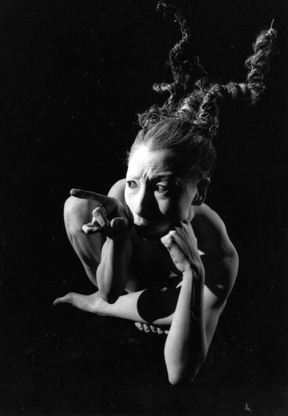Baseball, Butoh and the Imaginary Ballroom
Akemi Takeya
Bodypoems_reflection
Japan Society
Japan Society
New York, NY
November 4, 2005
By Tom Phillips
copyright ©2005 by Tom Phillips
 Akemi Takeya has been called a “post-Butoh” artist, and it makes sense in that her choreography goes beyond the elemental and visceral, and explores the roles and artifacts of civilized life. Among her five “Bodypoems” she played a shopper with a head cold, a baseball pitcher, and a high-strung fashionista with a toy dog. But the best of her pieces—the two that opened and ended the show – defied any neat definitions.
Akemi Takeya has been called a “post-Butoh” artist, and it makes sense in that her choreography goes beyond the elemental and visceral, and explores the roles and artifacts of civilized life. Among her five “Bodypoems” she played a shopper with a head cold, a baseball pitcher, and a high-strung fashionista with a toy dog. But the best of her pieces—the two that opened and ended the show – defied any neat definitions.
In the opening segment, called “Semidream,” she is a sleeper who rises in fits and starts, then discovers the bow of a stringed instrument. This she uses to carve the air, as she crosses the stage in loops and circles, a slow-motion ritual that might be drawn from Japanese Kendo, the sword-fighting martial art. Whatever she is doing in this half-sleep, it is creating art out of the primal conflicts of the mind. The accompaniment is slow plucked arpeggios on the guitar, the basic exercise of harmony.
Her closing piece, “Moon moss blossom,” is even more mysterious. Takeya enters naked from the waist up, faces a mirror to the rear and body-paints herself black all over. Then she climbs into the frame of a huge hoop skirt, with the fabric tucked up around the waist. She swirls the hoop as she moves, then releases the fabric, which cascades into a floor-length golden skirt. The lights slowly dim and she becomes a black silhouette, turning slowly with her arms spread wide, drifting on the air as the colors shift, then burn out into a dark violet. It looked like a distant relation of Suzanne Farrell’s haunted solo in “Vienna Waltzes,” but without the ballroom set. The hoop skirt stands in for the ball gown, but the naked black torso and face tell a different story, hinting at a harsher kind of suffering than a Viennese socialite might know.
Takeya, in fact, is a Vienna-based artist, an emigre from Japan whose program was sponsored jointly by the Japan Society and the Austrian Cultural Forum. Japan Society Performing Arts Director Yoko Shioya says she wants to reflect “the diaspora of Japanese artists” in the society’s programs, because Japanese artists are now a world-wide presence and speak a universal language.
 Parts of that language are more intelligible than others to an American audience. “Bessie’s Neidung” was a rant in increasingly squeaky Japanese, by a spoiled rich girl tethered to her tiny dog. But “Modern ball dance” was right over the plate. The very first line of Takeya’s bio says she was the pitcher on a baseball team as a child in Japan. “Modern ball dance” is a baseball ballet—beginning with a slow-motion port de bras of a pitcher stretching into a full windup, pausing with pointed foot, rearing and then suddenly whipping the ball home. I’ve seen many baseball bits by dancers, but never one that captured the quirky solemnity of this ritual. Following her third pitch she suddenly becomes a shortstop, diving, scrambling and pivoting to throw. Very few dancers can move with the grace and efficiency of Derek Jeter, or Orlando “el Duque” Hernandez, masters of that American dance form choreographed by a hardball flying at 100 miles per hour. But Takeya knows the moves, and she’s not imitating anyone; her skill comes from her own body-knowledge.
Parts of that language are more intelligible than others to an American audience. “Bessie’s Neidung” was a rant in increasingly squeaky Japanese, by a spoiled rich girl tethered to her tiny dog. But “Modern ball dance” was right over the plate. The very first line of Takeya’s bio says she was the pitcher on a baseball team as a child in Japan. “Modern ball dance” is a baseball ballet—beginning with a slow-motion port de bras of a pitcher stretching into a full windup, pausing with pointed foot, rearing and then suddenly whipping the ball home. I’ve seen many baseball bits by dancers, but never one that captured the quirky solemnity of this ritual. Following her third pitch she suddenly becomes a shortstop, diving, scrambling and pivoting to throw. Very few dancers can move with the grace and efficiency of Derek Jeter, or Orlando “el Duque” Hernandez, masters of that American dance form choreographed by a hardball flying at 100 miles per hour. But Takeya knows the moves, and she’s not imitating anyone; her skill comes from her own body-knowledge.
“Bodypoems_reflection” is not a perfect show. “How to cure a running nose” was a sneezing routine that went on too long, and never supplied the answer. But Takeya is always a pleasure to watch. She has the dramatic transformations of a Butoh dancer—the tension and control of slow movement, suddenly releasing into powerful impulses that fling the body out to its limits. Her reflections are also set off by two sensitive collaborators—German musician Marc Weiser, low-keyed on guitar and electronics, and Swiss lighting designer Reto Schubiger, who employs a full palette without ever distracting from the dance.
Volume 3, No. 41
November 7, 2005
copyright
©2005 Tom Phillips
www.danceviewtimes.com
|
|